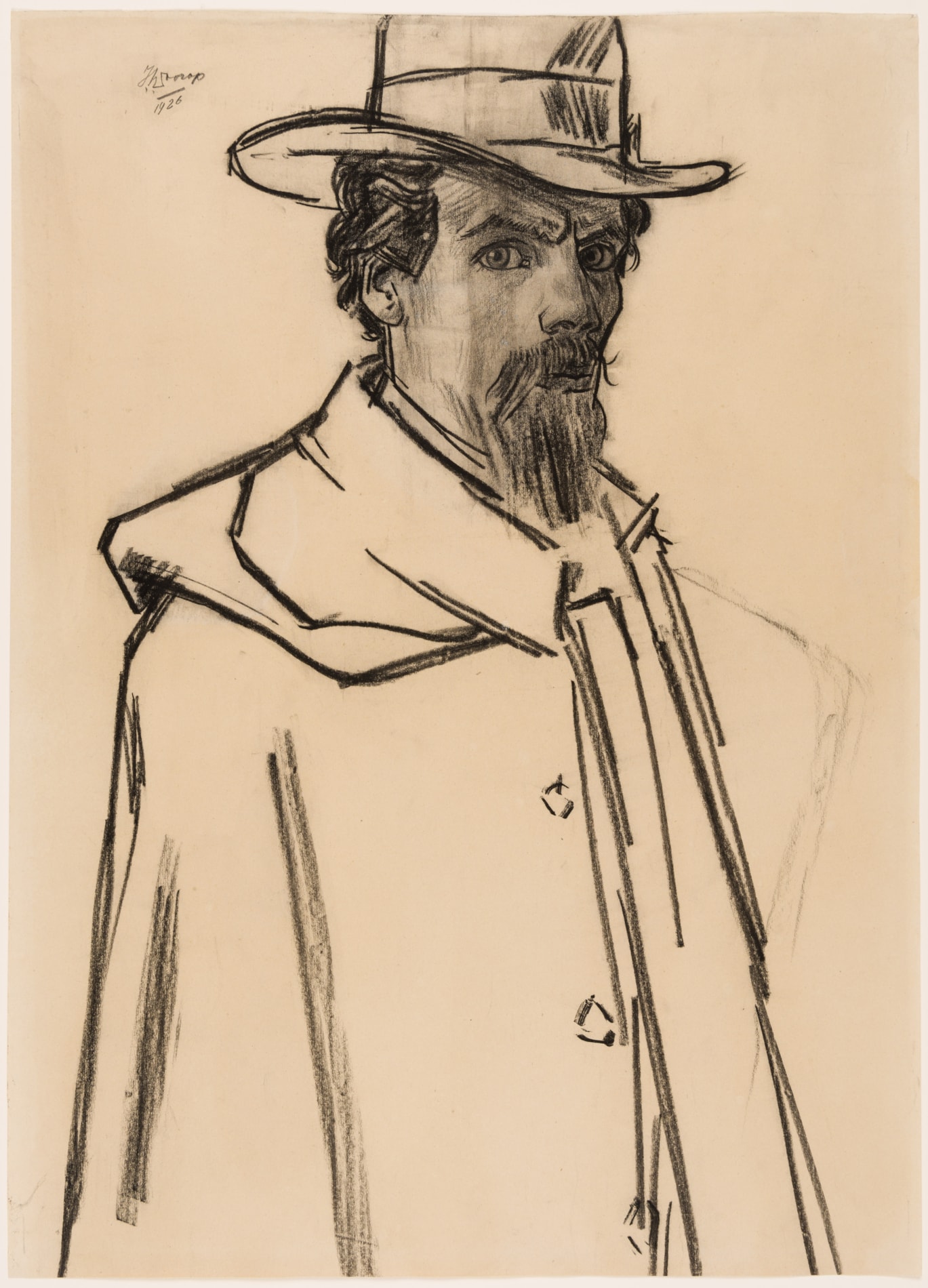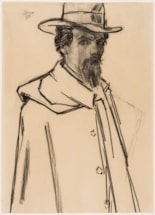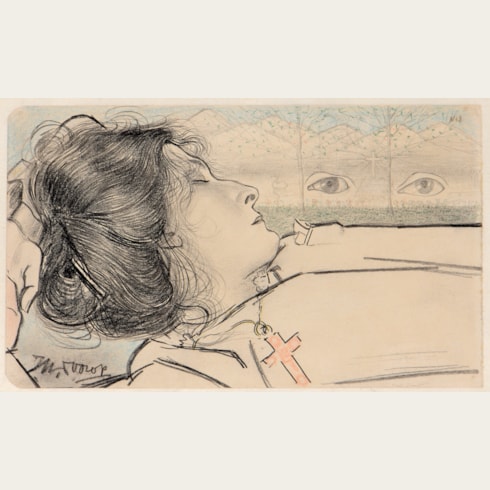Jan TOOROP
(Poerworedjo 1858 - The Hague 1928)
Portrait of the Artist Lambert Lourijsen
Sold
Charcoal on buff paper.
Signed and dated JthToorop / 1926 at the upper left.
564 x 408 mm. (21 3/4 x 16 in.)
Signed and dated JthToorop / 1926 at the upper left.
564 x 408 mm. (21 3/4 x 16 in.)
Jan Toorop was a superb portraitist, and produced a large number of drawn and painted portraits of family, friends and fellow artists, as well as many portraits – usually in the form of highly finished drawings - of some of the leading Dutch writers, poets, clergymen, politicians, lawyers, musicians, composers and intellectuals of his day. Indeed, Toorop may justifiably be claimed as one of the finest Dutch portraitists of the early 20th century.
Dated 1926, this large and striking drawing is a portrait of Toorop’s friend and pupil, the Dutch painter, goldsmith, glazier and mosaicist Lambertus Theodorus Cornelis Lourijsen (1885-1950). Born in Breda, Lourijsen settled in Amsterdam in 1902, studying first at the Rijksschool voor Kunstnijverheid and then at the Rijksakademie van Beeldende Kunsten, as well as at the Academie van Beeldende Kunsten in The Hague. He studied with Toorop, and worked alongside him on the decoration of the church of Sint-Bavo in Haarlem. (Toorop also served as a witness at Lourijsen’s wedding in 1914.) Lourijsen travelled to France and Italy and spent the early part of his independent career working as a portrait painter. In 1923, however, he moved to Haarlem and began devoting himself to creating decorative projects for churches, designing stained glass and mosaics, in which the influence of Toorop is evident, but also murals, altars, candlesticks, monstrances and carpets. His work can be seen to its best advantage in such complete works of interior ecclesiastical decoration as the church of Sint-Agatha in Beverwijk, executed in 1924, for which Lourijsen designed most of the main elements of the interior. Lourijsen also worked for churches in Bussum, Haarlem, the Hague, Halfweg, Heemskerck, Kralingen, Voorschoten and Zandvoort, and as well as the synagogue in Enschede.
Fifteen years before he made this drawing, Toorop painted a spirited small-scale portrait of Lambert Lourisjen, signed and dated 1911, which is today in the Kröller-Müller Museum in Otterlo. In the same year the artist used Lourisjen as the model for a sizeable drawing of The Apostle Paul, now in the offices of the Ministry of Education in Brussels, as well as a second large version of the same subject, dated 1912, now in the collection of the Museum Het Vallkhof in Nijmegen.
The first known owner of this drawing was the self-taught Dutch painter and draughtsman Bernardus (known as Ben) Viegers (1886-1947).
Dated 1926, this large and striking drawing is a portrait of Toorop’s friend and pupil, the Dutch painter, goldsmith, glazier and mosaicist Lambertus Theodorus Cornelis Lourijsen (1885-1950). Born in Breda, Lourijsen settled in Amsterdam in 1902, studying first at the Rijksschool voor Kunstnijverheid and then at the Rijksakademie van Beeldende Kunsten, as well as at the Academie van Beeldende Kunsten in The Hague. He studied with Toorop, and worked alongside him on the decoration of the church of Sint-Bavo in Haarlem. (Toorop also served as a witness at Lourijsen’s wedding in 1914.) Lourijsen travelled to France and Italy and spent the early part of his independent career working as a portrait painter. In 1923, however, he moved to Haarlem and began devoting himself to creating decorative projects for churches, designing stained glass and mosaics, in which the influence of Toorop is evident, but also murals, altars, candlesticks, monstrances and carpets. His work can be seen to its best advantage in such complete works of interior ecclesiastical decoration as the church of Sint-Agatha in Beverwijk, executed in 1924, for which Lourijsen designed most of the main elements of the interior. Lourijsen also worked for churches in Bussum, Haarlem, the Hague, Halfweg, Heemskerck, Kralingen, Voorschoten and Zandvoort, and as well as the synagogue in Enschede.
Fifteen years before he made this drawing, Toorop painted a spirited small-scale portrait of Lambert Lourisjen, signed and dated 1911, which is today in the Kröller-Müller Museum in Otterlo. In the same year the artist used Lourisjen as the model for a sizeable drawing of The Apostle Paul, now in the offices of the Ministry of Education in Brussels, as well as a second large version of the same subject, dated 1912, now in the collection of the Museum Het Vallkhof in Nijmegen.
The first known owner of this drawing was the self-taught Dutch painter and draughtsman Bernardus (known as Ben) Viegers (1886-1947).
Born and raised in Java in the Dutch East Indies, Jan (Johannes) Theodoor Toorop settled in Holland in 1872, at the age of fourteen. He studied in Delft, Amsterdam and Brussels, where he lived between 1882 and 1886. There he met James Ensor, with whom he travelled to Paris. In 1884 he became a member of the Belgian artistic and literary group Les XX (Les Vingt), formed the previous year and centred on Ensor, and proceeded to exhibit with the group for several years thereafter. His early work saw the artist working in a variety of styles, sometimes concurrently, ranging from Realism to Impressionism and Neo-Impressionism; the latter in particular was used for a series of splendid and brightly-coloured pointillist landscapes, as well as some portraits and genre scenes, until 1907. Toorop had his first exhibition in 1885, and the same year visited England, where he met James McNeill Whistler and discovered the work of the Pre-Raphaelite painters and William Morris. After his marriage to an Englishwoman in 1886, Toorop divided his time between England, Brussels and The Hague, as well as the small artist’s colony in the seaside resort of Katwijk aan Zee in Holland, where he lived from 1890.
In the early 1890s, influenced by the writings of Emile Verhaeren and Maurice Maeterlinck, Toorop began to work in a Symbolist vein, producing a number of large, complex and highly finished drawings which are among his most famous works. Perhaps the best known of these impressive Symbolist drawings - densely drawn and iconographically mysterious works in which the influence of Aubrey Beardsley and the Pre-Raphaelite painters is evident - are O Grave, Where is Thy Victory? of 1892, today in the Rijksmuseum in Amsterdam, and The Three Brides of 1892-1893, in the Kröller-Müller Museum in Otterlo. Toorop’s work began to be exhibited abroad, notably at the first Salon de la Rose + Croix in Paris in 1892 and at the Vienna Secession in 1900 and 1902, where it was a particular influence on the work of a slightly younger artist in Vienna, Gustav Klimt. By the turn of the century Toorop was established among the leading avant-garde artists in Holland, with his work influential in the development of the International Art Nouveau style.
Among Toorop’s first large-scale public commissions were three ceramic murals for the Beurs van Berlage, the stock exchange building in Amsterdam, completed in 1903. In 1905 Toorop, together with his daughter Charley, converted to Roman Catholicism, which would have a profound impact on his work for the remainder of his career. He began to produce a large number of often overtly religious works, many of which were reproduced as prints or in facsimile and displayed in private homes throughout the Low Countries. Among the few official commissions he received from the Catholic Church in Holland were designs for stained glass windows in the Sint Jozefskerk in Nijmegen, executed in 1913, as well as a series of paintings of the Stations of the Cross for the church of St. Bernulphus in Oosterbeek, begun in 1916 and completed in 1919. By this time he was in poor health, however, and by 1920 was largely confined to a wheelchair, with his left leg paralyzed. Nevertheless, he continued to work effectively, producing numerous drawings and prints.
As a draughtsman, Jan Toorop was extremely accomplished, both in his use of a range of materials and also in the effects he was able to achieve with them. As has been noted of his monumental drawings of the early 1890s in particular, ‘His Symbolist work, chiefly executed in pencil, black crayon and coloured chalk, was dominated by powerful draughtsmanship.’ Toorop produced designs for posters, book illustrations and covers, and postage stamps. He also made around fifty prints, mainly drypoints, for which he perferred to use zinc plates instead of the harder copper plates, which meant that only a few impressions of each print could be made. Toorop was also a superb portraitist, and produced a large number of drawn and painted portraits of family, friends and fellow artists, as well as many portraits – usually in the form of highly finished drawings - of some of the leading Dutch writers, poets, clergymen, politicians, lawyers, musicians, composers and intellectuals of his day. Indeed, Toorop may justifiably be claimed as one of the finest Dutch portraitists of the early 20th century.
Provenance
Bernardus Petrus (Ben) Viegers, Nunspeet
Galerie Erik H. Ariëns Kappers, Amsterdam, in 2013
Bernd Schultz, Berlin.
Galerie Erik H. Ariëns Kappers, Amsterdam, in 2013
Bernd Schultz, Berlin.






